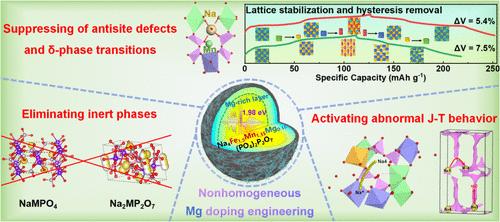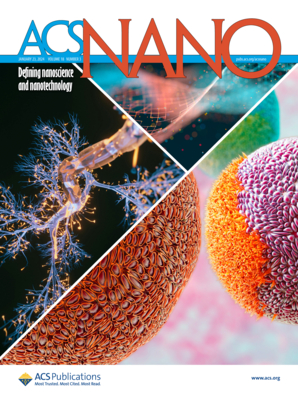Regulating Na/Mn Antisite Defects and Reactivating Anomalous Jahn–Teller Behavior for Na4Fe1.5Mn1.5(PO4)2(P2O7) Cathode Material with Superior Performance
IF 16
1区 材料科学
Q1 CHEMISTRY, MULTIDISCIPLINARY
引用次数: 0
Abstract
Na4Fe3–xMnx(PO4)2(P2O7) is considered a promising candidate for commercial-scale applications due to its significantly improved energy density compared to Na4Fe3(PO4)2(P2O7). However, challenges such as intractable impurities, voltage hysteresis/decay, and sluggish Na+ kinetics hinder their practical application. In this study, failure mechanisms of Na4Fe1.5Mn1.5(PO4)2(P2O7) are intensively investigated and demystified. It is found that the issues of this material are mainly caused by surface element segregation, Na/Mn antisite defects, and the closure of Na+ channels. To address these problems, a nonhomogeneous Mg doping engineering strategy is proposed, which effectively eliminates inert impurity phases, decreases the concentration of Na/Mn antisite defects, reactivates the anomalous Jahn–Teller behavior, and inhibits Mn dissolution. The synthesized ternary polyanionic cathode material, Na4Fe1.5Mn1.35Mg0.15(PO4)2(P2O7)@C–N, demonstrates significant improvements, featuring an average operating voltage of approximately 3.5 V, an energy density of 430 Wh kg–1 at 0.2C, and an ultralong cycle life (>12,000 cycles). This work highlights the nonhomogeneous Mg doping engineering strategy and provides a promising approach for developing cathode materials with high energy density for commercial-scale sodium-ion batteries.

性能优异的Na4Fe1.5Mn1.5(PO4)2(P2O7)正极材料Na/Mn反位缺陷的调控和异常Jahn-Teller行为的再激活
与Na4Fe3(PO4)2(P2O7)相比,Na4Fe3 - xmnx (PO4)2(P2O7)的能量密度显著提高,被认为是商业规模应用的有希望的候选材料。然而,诸如顽固性杂质、电压滞后/衰减和Na+动力学缓慢等挑战阻碍了它们的实际应用。在本研究中,深入研究了Na4Fe1.5Mn1.5(PO4)2(P2O7)的失效机制。发现该材料的问题主要是由表面元素偏析、Na/Mn反位缺陷和Na+通道封闭引起的。为了解决这些问题,提出了一种非均相Mg掺杂工程策略,该策略有效地消除了惰性杂质相,降低了Na/Mn反位缺陷的浓度,重新激活了异常的Jahn-Teller行为,并抑制了Mn的溶解。合成的三元聚阴离子正极材料Na4Fe1.5Mn1.35Mg0.15(PO4)2(P2O7) @C-N具有显著的改进,平均工作电压约为3.5 V, 0.2C时能量密度为430 Wh kg-1,超长循环寿命(>12,000次)。这项工作强调了非均质镁掺杂工程策略,为开发用于商业规模钠离子电池的高能量密度正极材料提供了一条有前途的途径。
本文章由计算机程序翻译,如有差异,请以英文原文为准。
求助全文
约1分钟内获得全文
求助全文
来源期刊

ACS Nano
工程技术-材料科学:综合
CiteScore
26.00
自引率
4.10%
发文量
1627
审稿时长
1.7 months
期刊介绍:
ACS Nano, published monthly, serves as an international forum for comprehensive articles on nanoscience and nanotechnology research at the intersections of chemistry, biology, materials science, physics, and engineering. The journal fosters communication among scientists in these communities, facilitating collaboration, new research opportunities, and advancements through discoveries. ACS Nano covers synthesis, assembly, characterization, theory, and simulation of nanostructures, nanobiotechnology, nanofabrication, methods and tools for nanoscience and nanotechnology, and self- and directed-assembly. Alongside original research articles, it offers thorough reviews, perspectives on cutting-edge research, and discussions envisioning the future of nanoscience and nanotechnology.
 求助内容:
求助内容: 应助结果提醒方式:
应助结果提醒方式:


